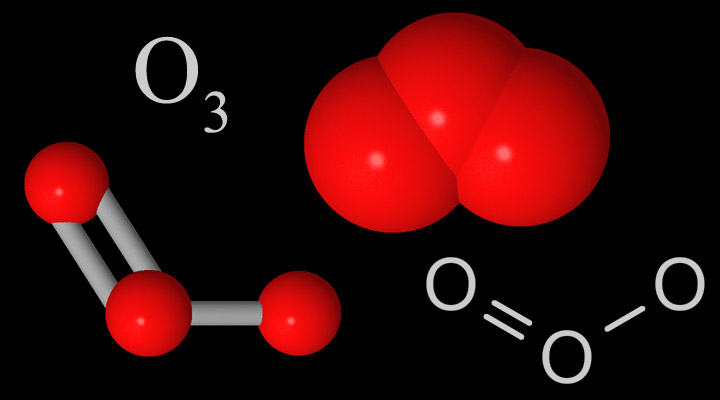6.2 - Stratospheric Ozone
1/16
Earn XP
Name | Mastery | Learn | Test | Matching | Spaced |
|---|
No study sessions yet.
17 Terms
Stratospheric Ozone
Key component of the atmospheric system because it protects living systems from the negative effects of ultraviolet radiation from the sun. Ozone molecules in this layer is good! Ozone in the troposphere is bad
Ozone
Found in 2 layer in two layers of the atmosphere. It’s a reactive gas mostly found in the so-called ____ layer in the lower stratosphere.
It’s also a greenhouse gas. It’s molecule made up of three oxygen atoms
In both the formation and the destruction of ozone, UV radiation is absorbed. Under the influence of UV radiation, oxygen molecules split into oxygen atoms. These atoms then combine with an oxygen molecule to form ____
It can also absorb UV radiation

Ozone Layer
An example of dynamic equilibrium because ozone is continuously made from oxygen atoms and is continuously converted back to oxygen.
Dynamic equilibrium in the Stratosphere
The rate of one reactions is equal to its opposite reaction. It’s balanced. Ozone destruction and creation is in equilibrium so it maintains it
CFC’s bond with singular oxygen atoms if they aren’t bonded with oxygen, leading to less O3 molecules and the equilibrium being broken
How do CFCs affect the stratospheric ozone?
CFCs released into environment by industries, rises up to stratosphere
Sunlight breaks CFCs up, releasing chlorine
Chlorine reacts with Ozone O3 and destroys Ozone, resulting in ozone destruction
More reactions cause more depletion
CFCs
Examples of sources of ___: pesticides, fire retardants, fridges, air conditioning units
They release chlorine atoms
Ultraviolet Radiation
Reaches the surface of the Earth and damages human living tissue
Effects of ultraviolet radiation:
Genetic mutations and subsequent effects on health
Damage to living tissues
Cataract formation in eyes
Skin cancers (risk is especially high in Australia and New Zealand)
Suppression of the immune system
Damage to photosynthetic organisms, phytoplankton
Damage to consumers of photosynthetic organisms, zoo plankton
Photosynthetic organisms are sensitive to UV radiation. This can have a disruptive effect on food pyramids
Benefits of UV Radiation (UV B)
Vitamin D for helping the body absorb calcium and form strong bones
Immune Regulation
Can be used to treat psoriasis and vitiligo
Used as a sterilizer as it kills pathogenic bacteria and as an air and water purifier
Industrial uses include lasers, viewing old scripts, forensic analysis, and lighting
Features of the different kinds of UV Radiation
UV-C : Has the highest energy (shortest wavelength) and is the most harmful type of UV with more than 99% of it being absorbed by the ozone layer
UV-A : Relatively harmless and has a longer wavelength (low energy)
UV-B : 50% is absorbed by the ozone layer
Montreal Protocol
Under the direction of UNEP, the ___________ (1987), 197 countries at the time agreed to protect the stratospheric ozone layer by phasing out the production and consumption of ozone-depleting substances like CFCs (chlorofluorocarbons)
At the time, it was the first universally ratified UN agreement. Since 1987, it has been strengthened in a series of 7 amendments and the LEDCs were given more time to implement the treaty
United Nations Environmental Programme (UNEP)
They are involved in:
Forging international agreements
Studies the effectiveness of these agreements and the difficulties in implementing and enforcing them
Gives information to states, organisations, and the public
Dynamic Equilibrium
The rate of one reactions is equal to its opposite reaction. It’s balanced.
Ozone-depleting substances (including CFCs)
Used in aerosoles, gas-blown plastics, pesticides, flame retardants, and refridgerants.
Halogen atoms (ex. chlorine) from these pollutants increase destruction of ozone in a repetitive cycle so allowing more ultraviolet to reach the Earth
Strategies for reducing ozone-depleting substances
(Altering the human activity producing pollution)
Replace gas-blown plastics
Replace CFCs with carbon dioxide, propane or air as a propellant
Replace aerosols with pump action sprays
Replace methyl bromide pesticides
Strategies for reducing ozone-depleting substances
(Regulating and reducing the pollutants at the point of emission)
Recover and recycle CFCs from refridgerators and AC units
Legislate to have fridges returned to the manufacturer and coolants removed and stored
Capture CFCs from scrap car air conditioner units
Strategies for reducing ozone-depleting substances
(Clean up and restoration)
Add ozone to or remove chlorine from stratosphere - not practical but it was suffested that ozone-filled balloons should be released